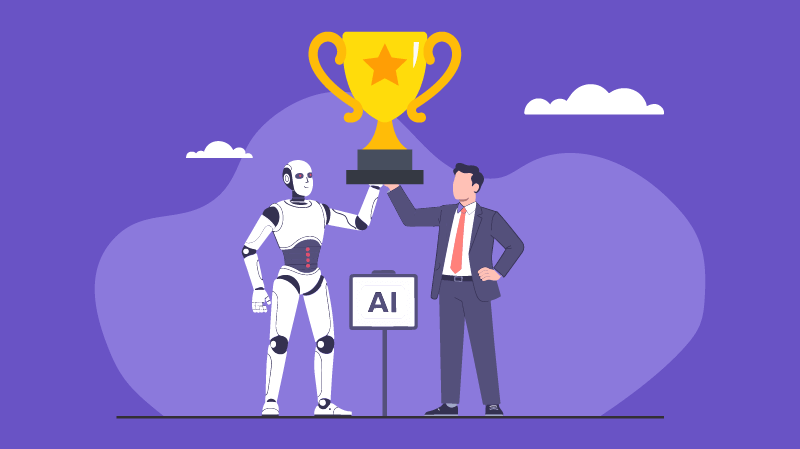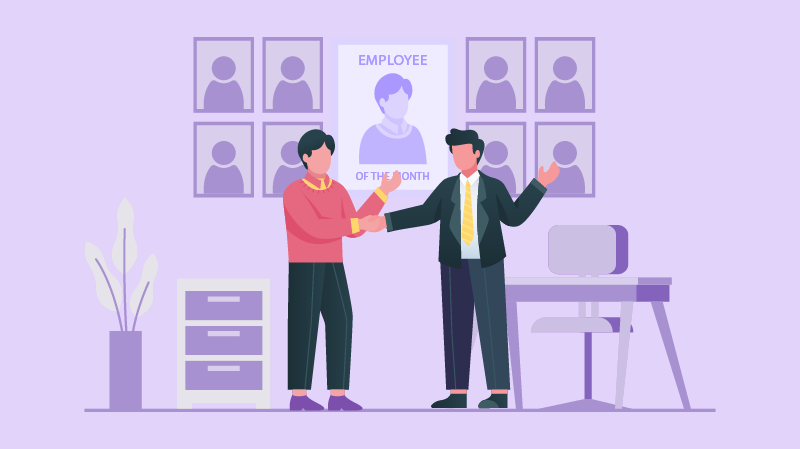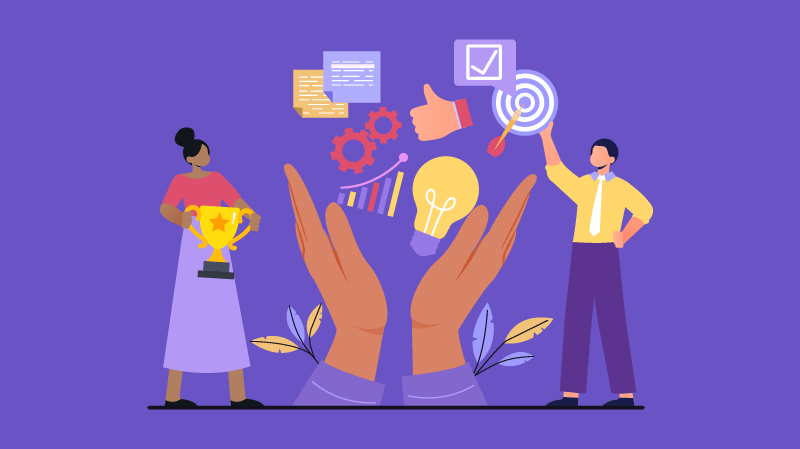Can AI Really Help Us Recognize Employees Better? Here's What’s Changing

A Global Employee Recognition and Wellness Platform
This is not the future. This is happening now.
– Partha Neog, CEO, Vantage Circle
That’s how the keynote opened at SHRM Tech this year and it couldn’t be more accurate.
We're at a turning point where AI isn't just reshaping how we work , it's redefining how we recognize, motivate, and retain talent.
Employee recognition has evolved from a tactical afterthought to a strategic imperative. With intelligent systems driving personalized, real-time appreciation, the era of sporadic thankyous and generic award programs is ending.
Forward-thinking organizations are leveraging AI-powered recognition not just to streamline appreciation but to amplify its impact. Those that don't adapt risk falling behind in the talent war.
This blog dives into the data driving this transformation, the frameworks making it strategic, and the real-world applications proving that AI-powered recognition isn't just changing employee experience—it's becoming a competitive advantage.
The Recognition Crisis: Why Traditional Approaches Fall Short
Here's a startling statistic: 80% of organizations are already implementing or piloting AI-driven recognition solutions.
In an industry where adoption typically crawls, eight out of ten companies have concluded that traditional recognition isn't working. This isn't early adoption, it indicates an urgentgent migration.
The problem runs deeper than occasional "thank you" messages. Traditional recognition suffers from what we call the "birthday card syndrome"—generic, impersonal, and easily forgotten.
The Data Tells the Story
Current workplace research reveals a recognition emergency:
Engagement Crisis: Only 21% of employees are actively engaged at work, while 62% remain disengaged and 17% are actively undermining their workplace (Gallup, 2024).
Retention Emergency: 51% of workers believe it's a good time to find a job, while 50% are actively seeking new opportunities,meaning half your workforce has one foot out the door
Economic Impact: Declining employee engagement costs the global economy $438 billion annually in lost productivity (Gallup )
Program Effectiveness Gap: While 91% of organizations have rewards programs and 94% have recognition programs only
31% rate them as effective.
The disconnect is clear, traditional recognition happens in silos, missing the collaborative work that defines modern teams. With younger generations expecting meaningful experiences and remote work changing relationship dynamics, strategic recognition has become a competitive necessity.
The AI Transformation: From Reactive to Proactive Recognition
Let's explore what's possible with a real workplace scenario using intelligent recognition systems.
Lisa's Monday Morning Revolution
Lisa, a marketing manager, faces a familiar challenge. Recognition matters, but between meetings and deadlines, appreciation falls through the cracks.
Then her Microsoft Teams sends a gentle notification: "You haven't recognized a teammate recently. Would you like to see who might benefit from the appreciation?"
Instead of relying on memory or guesswork, the AI system:
Analyzes conversation history across Teams, emails, and project documents
Identifies overlooked contributors: Mary and Alicia haven't been recognized in 30+ days despite significant project involvement
Generates specific insights: Mary's empathy and proactive approach to Campaign X emerge from conversation analysis
Crafts personalized messages based on actual work interactions
Suggests appropriate recognition with customized messaging
The process takes under two minutes. Mary receives meaningful recognition tied to her actual contributions. Lisa doesn't need to remember details or craft messages from scratch.
This doesnt mean that automation is replacing human connection but reflects how AI is amplifying it by surfacing genuine contributions that might otherwise go unnoticed.
How Intelligent Recognition Works: The 4 R's Framework
Modern AI-powered recognition operates through four key mechanisms that leading platforms like Vantage Circle have identified as essential for systematic appreciation:
- Recognition Reminder
-
AI analyzes activities and milestones to identify recognition moments
-
Proactively prompts managers through notifications
-
Creates systematic touchpoints that prevent appreciation gaps
- Recognition Reasoning
-
Provides context and data-driven justification for suggested recognition
-
Explains which contributions deserve acknowledgment
-
Makes appreciation specific and tied to organizational values
- Recognition Recommendation
-
Offers personalized guidance on effective recognition delivery
-
Suggests appropriate messages, badges, and awards
-
Tailors recommendations based on recipient preferences
- Recognition Reinforcement
-
Tracks patterns to ensure consistent appreciation
-
Builds long-term motivation rather than one-off acknowledgments
-
Creates cycles that strengthen desired behaviors over time
The Strategic AIRe Framework
Successful organizations apply the AIRe approach—a strategic framework developed by Vantage Circle to transform recognition from checklist item to culture driver:
The AIRe Pillars:
-
A – Appreciation
Go beyond surface-level thank-yous. Recognize specific actions and behaviors that align with your organization’s values and goals. -
I – Incentivization
Motivate the right behaviors through meaningful rewards—monetary or non-monetary. Use data to ensure incentives reinforce desired outcomes, not just output. -
R – Reinforcement
Consistency is key. Build systems that reinforce appreciation over time to strengthen habits, drive performance, and build team trust. -
e – Emotional Connect
Recognition must feel real. Infuse appreciation with empathy, authenticity, and emotional intelligence to foster deep human connection.
When organizations implement AIRe, they create a recognition culture rooted in purpose—not just performance—and one that balances logic, motivation, and emotional resonance.
Research shows organizations prioritizing recognition are 12x more likely to have strong business outcomes, while highly engaged teams achieve 23% higher profitability.
Beyond Generic Praise: The Psychology of Achievement
Modern recognition platforms like Vantage Recognition are transforming workplace appreciation through intelligent gamification—but these aren't participation trophies.
Merit-based badge systems tap into "progress loops"—visible achievements that create motivation cycles. When people see progress, feel accomplished, and are motivated to continue positive behaviors.
Badges like "Team Player," "Encouragement Expert," or "Agility Ace" are awarded based on real-time recognition data. When Sarah earns the "Encouragement Expert" badge after consistent peer recognition, this visible achievement validates her efforts while signaling that recognition is valued behavior.
The psychology is powerful: when positive behaviors become visible and celebrated, they spread organically throughout the organization.
Recommended Read: Employee Recognition Badges for Digital Recognition: Ideas & Examples
Addressing Common Concerns
"Won't AI make recognition feel robotic?" The goal isn't to automate appreciation—it's to surface opportunities for genuine human connection. AI identifies moments and provides context; humans add the personal touch.
"What about privacy concerns?" Leading platforms use aggregated data patterns, not individual message content. The focus is on collaboration frequency and project involvement, not private communications.
"Is this just another tech trend?" The statistics suggest otherwise. With 80% adoption rates and measurable ROI, this represents fundamental workplace evolution, not temporary fashion.
Measurable Impact: The Business Case
The ROI of AI-powered recognition is substantial:
31% lower turnover in companies with strong recognition programs
14% improvement in workplace performance through peer recognition
51% turnover reduction in highly engaged teams
$16.1 million annual savings in turnover costs for 10,000-person companies
Beyond numbers, there's qualitative transformation. As one client explains: "Recognition programs have become our secret sauce for creating winning cultures, resilient teams, and business success."
Implementation Success: Your Strategic Roadmap
Phase 1: Foundation
-
Audit current recognition frequency and quality
-
Identify who gets recognized and when
-
Establish baseline engagement metrics
Phase 2: Framework Selection
-
Choose systematic approaches over ad-hoc appreciation
-
Prioritize integration with existing tech stacks
-
Focus on user experience for adoption success
Phase 3: Measurement & Optimization
-
Track recognition quality, not just frequency
-
Correlate appreciation with engagement and retention
-
Refine based on data insights
Phase 4: Scale & Sustain
-
Train managers on emotional intelligence in recognition
-
Encourage peer-to-peer appreciation

-
Maintain human connection while leveraging AI insights
Keeping Recognition Human in a Digital World
Remember these principles:
Surface, don't substitute: Let technology identify opportunities while keeping messages personal
-
Be specific, not scripted: Customize based on real actions and outcomes
-
Balance timing: Blend real-time appreciation with deeper acknowledgment
-
Enable peer connection: Empower employees to recognize each other meaningfully
-
Lead with empathy: Ask "How can I make this feel genuine?" not "How fast can I complete this?"
The Bottom Line: Recognition as Competitive Advantage-Five Keys to AI Recognition Success
The transformation happening right now isn't just about better technology—it's about fundamentally changing how organizations connect with their people. Here's what forward-thinking leaders need to know:
AI transforms recognition from reactive to strategic. Manual recognition falls through the cracks. AI-powered systems make appreciation systematic, data-driven, and impossible to ignore. Organizations using intelligent recognition see 31% lower turnover—that's not coincidence, it's competitive advantage.
Personalization drives authentic impact. Generic "thank you" messages create the birthday card syndrome we discussed. AI analyzes individual preferences and contributions to craft recognition that feels genuine. When employees believe appreciation is tailored to them specifically, engagement follows.
Automation frees leaders to lead. Stop spending hours tracking who deserves recognition and when. AI handles the administrative burden while you focus on strategic culture building. The time savings alone justify the investment—but the cultural transformation delivers lasting value.
AI helps eliminate recognition blind spots. Quiet performers and remote workers often get overlooked in traditional recognition. AI identifies contributions across all team members more consistently than human memory alone. Just remember to maintain oversight to ensure the system stays fair.
Implementation strategy determines success or failure. Technology alone won't transform your culture. Transparent communication about data use, integration with existing workflows, and manager training separate successful rollouts from expensive mistakes. Start with pilot programs, measure relentlessly, and scale what works.
Companies embracing this shift early will build cultures where contributions are consistently noticed, appreciated, and reinforced. They'll retain top talent not just through compensation but through meaning and connection.
The frameworks, technology, and expertise exist today. The only question is whether you'll use them to create your competitive advantage.
Ready to explore AI-powered recognition for your organization? Start by auditing your current recognition patterns, identifying gaps, and researching platforms that integrate with your existing technology stack. The future of workplace appreciation isn't coming—it's already transforming organizations that choose to embrace it.


















